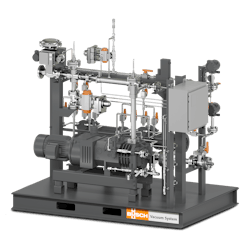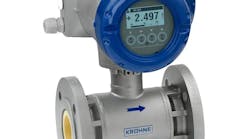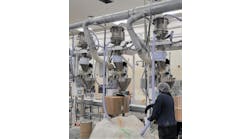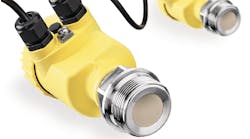How Smarter Vacuum Pumps Drive Sustainability in Chemical Plants
In the chemical industry, digitalization and emissions monitoring are pressing operational challenges. While exploring the technological innovations behind these trends, attention often shifts to advanced software and precision sensing technologies. But the critical components that ensure the smooth operation of a process plant can be overlooked. Central to many operations, vacuum pumps are crucial for various chemical processes, from managing raw materials to distillation.
As the industry navigates the dual demands of sustainability and efficiency, these systems must not only perform reliably but also deliver on ambitious carbon-reduction targets while integrating with digital networks. This allows for continuous monitoring and the agile optimization of operations, marrying environmental responsibility with operational efficiency.
To illustrate the role of vacuum pump technology in meeting the modern demands of chemical manufacturing, Chemical Processing spoke with Alex Hitsman, chemical and pharmaceutical business development manager at Bush Vacuum Solutions. The following is an edited version of that conversation.
Alex, let's set the stage here by first discussing the evolution of vacuum pumps and chemical applications. Can you talk a little bit about that?
AH: Originally, vacuum pumps were what we'd call a Venturi style or a steam jet vacuum pump. The earliest version of pumps. We then moved to liquid ring pumps, and they took over in the 1970s. With the Clean Water Act, it became more of a priority to produce less manufacturing waste. That put a large push to move toward dry technologies as we went through the years. And that's really refined itself, and a lot of our industry is moving toward dry technology as a result of the changes that took place in the seventies.
I imagine that reliability and maintenance are key factors in this evolution. What are some of the key challenges chemical plant operators face when it comes to maintaining vacuum pumps?
AH: That's been changing over the years. With a lot of the turnover that we've seen in staffing, companies are looking for a product that requires less maintenance, less complicated maintenance, more time between maintenance events and more time between downtime events that limit or stop production. That's a big piece of why we've moved to dry technology.
“These unique chemistries, as we've evolved as a manufacturer, as an industry, there's been more of a focus on providing solutions to helping our chemical process customers look at more than just the vacuum pump to look at the system around it and to help with building that system.” -- Alex Hitsman, chemical and pharmaceutical business manager, Busch Vacuum Solutions
Reliability and maintenance oftentimes go hand in hand with sustainability. Can you talk a little bit about how vacuum pumps are evolving to deliver on carbon reduction goals?
AH: Yeah, as I'd mentioned before, when we're looking at that carbon-reduction goal, carbon capture is a big piece of what we're seeing in the industry nowadays. To have a pump in that environment, we want it to be as efficient as possible, and that usually then puts us back to the dry-screw or dry claw technology. With liquid-ring technology or a steam jet, we're pressurizing, we're heating up liquid in order to make that steam. With the liquid ring technology, we're continuously pumping liquid into that pump to create the sealing barrier, and all of that, moving that, creating the heat, creating the liquid seal barrier takes energy. So, you don’t just have the liquid ring pump, you also have a secondary pump that will be pumping that flow rate into the vacuum pump. With the dry technologies you don't have that, so the energy is initially less, and also your waste production is lower. And when we're trying to keep our carbon footprint as low as possible, those technologies help us get there.
Can you talk a little bit about how advancements in sensor technology and control systems have impacted the performance and reliability of vacuum pumps?
AH: A lot of our research and development has been in those areas over the last few years. We currently have a product called OTTO that actually attaches to the pump and monitors temperature and vibration for example, to keep track of the health and life of the vacuum pump, while they're actually in process running on an application. That helps us forecast for preventative maintenance. It helps us avoid downtime, even by knowing it's time to switch on a spare pump versus letting that pump run to the point of failure. And that kind of technology, along with keeping maintenance as low as possible maintains uptime. This has been where we've seen the demand from customers and the driving force behind technologies like OTTO.
Some chemical manufacturers have very specific requirements. Can you talk a little bit about how the vacuum pump industry evolves to meet some of these specialized needs?
AH: For a lot of the chemical plants out there, the technology that we have in place is really about a system and a support structure. With more unique chemical products, there's been more of a focus on providing system solutions including accessories like filters and knockout pots. Along with the monitoring that also goes into it to ensure that we have the best technology, the best system and solution for the application.
You've discussed a lot of important issues that chemical operations encounter when it comes to vacuum pumps. Can you share some examples of successful implementations of some of these technologies?
AH: A lot of the success we've seen in recent years is moving customers to dry technology, including technology like OTTO or variable frequency drives (VFDs), that let us monitor the pump, and let us slow it down for energy savings. Accessories provide the opportunity to watch for upset conditions and then have the pump in real time react to those conditions. For example, if we have a process upset and some process liquids come over, we can monitor amps, watch for that upset, slow the pump down during that upset condition, and then once that condition is passed, the pump can speed back up and help protect itself.
Are there any innovative materials or designs being used in the latest vacuum pumps to enhance their durability and resistance to corrosive chemicals?
AH: For most of our pumps that are designed and marketed toward the chemical industry, we can build them out of special materials or construction. For our liquid ring vacuum pumps that includes special alloys. For the dry technology, that's where we'll start to look at special coatings that we will put on the inside metal materials of the pump to help protect against corrosion. And then we'll also spend a lot of time looking at the right seal materials, the right gasket materials, the correct seal faces for those hazardous situations.
So in terms of safety, what measures have been implemented in the latest vacuum pump designs to mitigate risks associated with handling hazardous chemicals?
AH: Safety is obviously important to everybody. We want people to use our equipment and use it safely for very hazardous chemicals. We've put purge systems on most of our sealing chambers that press the gases back into the process area. That's one piece of it. The other thing that we've seen over time is a greater drive for noise considerations. Providing a work environment that is safer and more enjoyable for employees is a continuing trend that we see. And although the noise limit customers would like to see is below 85 decibels, we've seen more people request below 80 decibels or as low as they can get. And again, that dry-screw technology, especially the screw-pump technology, lends itself toward that low-decibel sound.
Is there anything else you'd like to add about the future of vacuum pump technologies and its importance in chemical operations.
AH: As we go through these changes that we're all experiencing in the world right now, I'd like to support the idea of building a strong network, knowing who to reach out to and find the support when designing a vacuum system when trying to evaluate or maintain your system. This is a big piece of how we all collaborate together, come up with the best solution and move our production facilities forward.
For more information, visit: https://buschvacuum.com.





